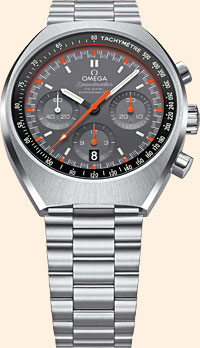Watchmakers weigh the challenge of change

Roula Khalaf, Editor of the FT, selects her favourite stories in this weekly newsletter.
Received wisdom advises against changing a winning team. But should watchmakers change a winning design?
Brands have been struggling with the question for decades, some reissuing old and classic models with subtle changes, others opting to leave well alone.
In 2012, Audemars Piguet reinvented its Royal Oak for the model’s 40th anniversary, while Jaeger-LeCoultre, TAG Heuer and IWC have reissued classic models in recent years. “This is a subject that comes up consistently,” says Elizabeth Doerr, author of Twelve Faces of Time, a book about the history and importance of haute horlogerie. “A few of these are iconic watches that have been around for 40, 50 years, and they do need freshening to appeal to the next generation.”
Luca Solca, head of global luxury at Exane BNP Paribas, the investment company, says classic models sometimes pose sales challenges. An ageing bestseller, he says, “is a big problem, as you risk erosion of your market position”.
According to Mr Solca, the best way to revamp a classic is by introducing “a variation on a theme” – he cites the example of Burberry’s checked pattern, which was introduced as a lining for its coats in 1924. The brand has in recent decades reproduced the pattern on items such as fragrance packaging and sunglasses.
In watchmaking, he says Jaeger-Le Coultre has tackled the problem most effectively with its Grande Reverso Ultra-thin Tribute to its 1931 model, a reissue faithful to the original, except larger and thinner. In both cases the brands introduced subtle changes.
But Mr Solca says not all reinventions are successful: “Different brands have different degrees of success.”
Reissues are important for brands hoping to stay relevant to a new generation, and they can help a brand “grow in a growing market,” says Mr Solca.
“The Swatch Group – Omega in particular – has been exemplary in how to go big and wide with an industry icon and attract a consumer that probably didn’t care about watches before,” says Ms Doerr. The brand surprised the industry when it reissued its Moonwatch for Baselworld 2013.
The model called Dark Side of the Moon, is an “amazing evolution”, says Ms Doerr, from the original model, worn by Nasa astronauts. “We haven’t been to the moon since 1972,” says Jason Heaton, author of Build the Ultimate Watch Collection. “It’s kind of a crazy thing to keep referring to, but they’re very successful at it.”
Other brands, such as Rolex, and Panerai, choose not to revamp models, believing their design to be “perfect as is”, says Ms Doerr.
Mr Solca says that because Panerai is “a niche brand, which has built a business on its iconic models,” there is low risk of déjà vu for consumers.
“I am more concerned for Rolex,” he adds. “Rolex is mainstream and very big, and it competes head to head with large brands such as Omega, Cartier and TAG Heuer.”
The best approach, according to Mr Solca, would be “continuously to nourish and update your best-sellers”.
Omega will be hoping to do that when it reissues the Speedmaster Mark II, a model first issued 45 years ago, and not touched since.
“I’m OK with a brand revamping anything it chooses, and I encourage it. I’m quite happy to see a lot of brands innovating, and experimenting with new materials, sizes, and movements,” says Mr Heaton. “As long as they’re building quality products, I like that these brands are taking risks. If a watch always stays as it was, what’s the point?”
——————————————-
Time machine: Classic has a facelift

Omega’s classic watch, the Speedmaster Mark II is receiving a facelift for the first time in 45 years. In July 1969, it was worn on the first moon landing, since when it has been known as the Moonwatch.
Stephen Urquhart, president of Omega, says: “The challenge is to create a product that expresses the essence of the original while producing a fine contemporary wristwatch.”
To achieve this, Omega’s design team made only subtle aesthetic changes to the original model, such as the inclusion of a date window at the 6 o’clock position, while focusing inside the watch for the bigger developments.
The new version has the immediately recognisable tonneau-style case shape that defined the 1969 model, while the familiar orange chronograph second hand and bright hour markers are also back, set against a dark grey background.
However, the automatic coaxial calibre inside the case has a silicon balance spring, which represents a significant technological evolution from the original calibre 861, as it adds to the movement’s durability.
The result is a mechanism that is “fully in the keeping with innovative watchmaking,” says Mr Urquhart, just as the original Mark II was 45 years ago.
Robert-Jan Broer, an industry watcher who blogs about time pieces at Fratello Watches.com, defends the redesign, saying that it respects the spirit of the original.
He says: “The case looks very similar. The bracelet is really nicely done. It’s like a true re-edition of the 1969 model.”
But he admits that he was surprised when Omega announced the new Mark II. “To be brutally honest, I didn’t see this one coming.”
While he is an Omega collector, he does not expect to see aficionados seek it out.
“You have a lot of Speedmaster collectors but they are really focused on the Moonwatch, the Speedmaster Professional, and the models from 1957 to 1966,” says Mr Broer.
“Only a few are really into the Mark II, Mark III, Mark IV and Mark V series.”
But Omega is not targeting that market. “This is a Speedmaster Mark II for a new generation of enthusiasts,” says Mr Urquhart.
Omega’s demographic has broadened, attracting younger customers in recent years. This is “a very positive development,” says Mr Urquhart.
The most effective way of keeping younger buyers, Omega says, is by promoting its heritage.
“We’ve found that tapping into the pioneering spirit that defined that era resonates with people who had not been born when the original Speedmaster Mark II was introduced,” says Mr Urquhart.
Watch writer Jason Heaton, a child when the original was released, recognises the pull of sentimental designs:
Most of us like watches that have some element of . . . nostalgia, and I think Omega is doing a good job of that.”
Comments